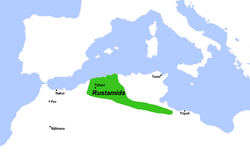Rustamid Kingdom | |||||||||||
|---|---|---|---|---|---|---|---|---|---|---|---|
| 777[1]–909 | |||||||||||
 Approximate extent of Rustamid control in the 9th century | |||||||||||
| Capital | Tahert | ||||||||||
| Common languages | Berber, Arabic, Persian | ||||||||||
| Religion | Ibadi Islam | ||||||||||
| Government | Imamate[2] | ||||||||||
| Imam | |||||||||||
• 777–788 | ʿAbdu r-Rahman ibn Bahram ibn Rūstam | ||||||||||
• 906–909 | Yaqzan ibn Muhammad Abil-Yaqzan | ||||||||||
| History | |||||||||||
• Established | 777[1] | ||||||||||
• Disestablished | 909 | ||||||||||
| |||||||||||
| Today part of | Algeria Tunisia Libya | ||||||||||
The Rustamid dynasty (Arabic: الرستميون) (or Rustumids, Rostemids) was an Ibadi Persian dynasty[3][4] centered in present-day Algeria.[5][6][7] The dynasty governed as a Muslim theocracy for a century and a half from its capital Tahert (present day Tagdemt[8]) until the Ismaili Fatimid Caliphate defeated it. Rustamid authority extended over what is now central and western Algeria, parts of southern Tunisia, and the Jebel Nafusa and Fezzan regions in Libya as far as Zawila.[9][10][11][12]
- ^ A Chronology of Islamic History, 570-1000 CE - Habib Ur Rahman G.K. Hall, 1989
- ^ The Transmission of Learning in Islamic Africa - Scott Steven Reese
- ^ Bosworth, C.E., ed. (1995). Encyclopedia of Islam (New ed.). Leiden [u.a.]: Brill [u.a.] p. 638. ISBN 9004098348.
- ^ Islamic History - Laura Etheredge - p73
- ^ Britannica Encyclopedia, Retrieved on 18 December 2008.
- ^ "The Places where Men Pray Together", pg. 210.
- ^ Based on Britannica 2008: The state was governed by imams descended from ʿAbd ar-Raḥmān ibn Rustam, the austere Persian who founded the state in the 8th century.
- ^ Abun-Nasr, Jamil M. (1971). A history of the Maghrib. Internet Archive. Cambridge [Eng.] University Press. p. 75. ISBN 978-0-521-07981-5.
- ^ Bosworth, Clifford Edmund (2004). "The Rustamids". The New Islamic Dynasties: A Chronological and Genealogical Manual. Edinburgh University Press. ISBN 9780748696482.
Here, 'Abd al-Raḥmān in 144/ 761 founded a Khārijī principality based on the newly-founded town of Tahert (Tāhart) (near modern Tiaret), and some fifteen years later he was offered the imamate of all the Ibāḍiyya of North Africa. This nucleus in Tahert was linked with Ibāḍī communities in the Aurès, southern Tunisia and the Jabal Nafūsa, and groups as far south as the Fezzān oasis acknowledged the spiritual headship of the Ibāḍī Imāms.
- ^ Anderson, Glaire D.; Fenwick, Corisande; Rosser-Owen, Mariam (2017). The Aghlabids and their Neighbors: Art and Material Culture in Ninth-Century North Africa. Brill. p. 3. ISBN 978-90-04-35604-7.
The Kharijite Rustamid state based at Tahert (western Algeria) was also established by a Persian missionary, ʿAbd al-Rahman b. Rustam of the Ibadi tradition. Their area of influence stretched to Jerba, Jabal Nafusa, and the Fazzan.
- ^ Syed, Muzaffar Husain; Akhtar, Syed Saud; Usmani, B. D. (2011). Concise History of Islam. Vij Books India Pvt Ltd. p. 143. ISBN 978-93-82573-47-0.
The Rustamid (Rustumid, Rostemid) dynasty of Ibadi Kharijite Imam that ruled the central Maghrib as a Muslim theocracy for a century and a half from their capital Tahert in present Algeria until the Ismailite Fatimid Caliphate destroyed it. (...) The exact extent of its dominions is not entirely clear, but it stretched as far east as Jabal Nafusa in Libya.
- ^ Brett, Michael (2013). Approaching African History. Boydell & Brewer Ltd. p. 154. ISBN 978-1-84701-063-6.
After the great Kharijite rebellion this encampment developed into the oasis city of Zawila, at the south-eastern extremity of the Kharijite realm of the Rustamids of Tahart.